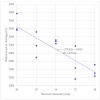Acetabular Wall Weakening in Total Hip Arthroplasty: A Pilot Study
- PMID: 37092522
- PMCID: PMC10123709
- DOI: 10.3390/pathophysiology30020008
Acetabular Wall Weakening in Total Hip Arthroplasty: A Pilot Study
Abstract
Total hip arthroplasty is a widely performed operation allowing disabled patients to improve their quality of life to a degree greater than any other elective procedure. Planning for a THA requires adequate patient assessment and preoperative characterizations of acetabular bone loss via radiographs and specific classification schemes. Some surgeons may be inclined to ream at a larger diameter thinking it would lead to a more stable press-fit, but this could be detrimental to the acetabular wall, leading to intraoperative fracture. In the attempt to reduce the incidence of intraoperative fractures, the current study aims to identify how increased reaming diameter degrades and weakens the acetabular rim strength. We hypothesized that there is proportionality between the reaming diameter and the reduction in acetabular strength. To test this hypothesis, this study used bone surrogates, templated from CT scans, and reamed at different diameters. The obtained bone surrogate models were then tested using an Intron 8874 mechanical testing machine (Instron, Norwood, MA) equipped with a custom-made fixture. Analysis of variance (ANOVA) was used to identify differences among reamed diameters while linear regression was used to identify the relationship between reamed diameters and acetabular strength. We found a moderate correlation between increasing reaming diameter that induced thinning of the acetabular wall and radial load damage. For the simplified acetabular model used in this study, it supported our hypothesis and is a promising first attempt in providing quantitative data for acetabular weakening induced by reaming.
Keywords: acetabular strength; arthroplasty; hip; rim fracture.
Conflict of interest statement
The authors declare no conflict of interest.
Figures



Similar articles
-
Periprosthetic occult acetabular fracture: an unknown side effect of press-fit techniques in primary cementless total hip arthroplasty.Eur J Orthop Surg Traumatol. 2021 Oct;31(7):1411-1419. doi: 10.1007/s00590-021-02894-5. Epub 2021 Feb 13. Eur J Orthop Surg Traumatol. 2021. PMID: 33585969
-
Deeper Central Reaming May Enhance Initial Acetabular Shell Fixation.Arthroplast Today. 2020 Jun 8;6(3):343-349. doi: 10.1016/j.artd.2020.03.012. eCollection 2020 Sep. Arthroplast Today. 2020. PMID: 32548228 Free PMC article.
-
Restoration of the centre of rotation in primary total hip arthroplasty: the influence of acetabular floor depth and reaming technique.Bone Joint J. 2016 Dec;98-B(12):1597-1603. doi: 10.1302/0301-620X.98B12.BJJ-2016-0345.R1. Bone Joint J. 2016. PMID: 27909120 Clinical Trial.
-
Total hip arthroplasty in acetabular fractures.J Clin Orthop Trauma. 2020 Nov-Dec;11(6):1090-1098. doi: 10.1016/j.jcot.2020.10.037. Epub 2020 Oct 17. J Clin Orthop Trauma. 2020. PMID: 33192013 Free PMC article. Review.
-
Primary total hip arthroplasty after acetabular fracture.Instr Course Lect. 2001;50:335-54. Instr Course Lect. 2001. PMID: 11372332 Review.
Cited by
-
Surgical Approaches in Total Hip Arthroplasty.J Orthop Sports Med. 2023;5(2):232-240. doi: 10.26502/josm.511500106. Epub 2023 May 15. J Orthop Sports Med. 2023. PMID: 37388321 Free PMC article.
References
-
- Wodzisławski W., Krupa S., Nowicki J., Bedziński R., Detyna J. The reaction of the pelvis to the implantation of the acetabular component of the hip endoprosthesis—Initial tests with the use of computerized tomography. Acta Bioeng. Biomech. 2009;11:45–54. - PubMed
-
- Wolford M.L., Palso K., Bercovitz A. Hospitalization for total hip replacement among inpatients aged 45 and over: United States, 2000–2010. NCHS Data Brief. 2015;186:1–8. - PubMed
LinkOut - more resources
Full Text Sources
